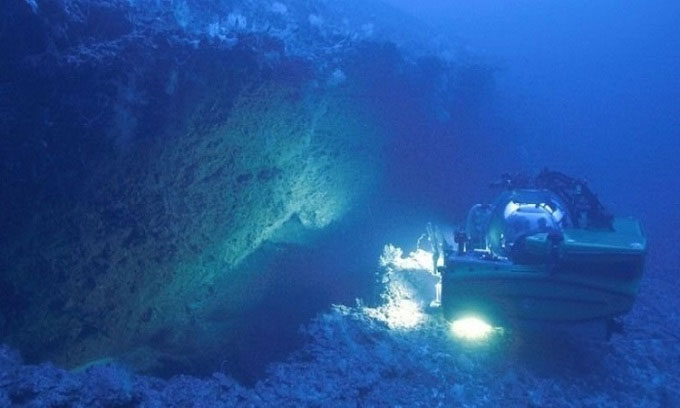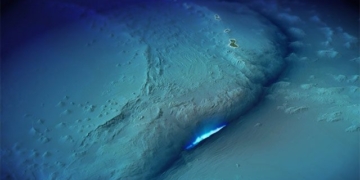Researchers predict that a massive tsunami could devastate the coastal regions of Egypt and Saudi Arabia based on evidence of a landslide that occurred 500 years ago in the Red Sea.
In a discovery published on February 3 in the journal Geophysical Research Letters, researcher Sam Purkis observed a wide fissure 3 meters deep and 8 meters high at a depth of 900 meters in the Tiran Strait. “Immediately, I realized we were looking at the remnants of geological activity that shattered the seabed,” recalled Purkis, a marine geologist at the University of Miami.

Submarine exploring the underwater fissure. (Photo: University of Miami).
Further research revealed that this was the result of an underwater landslide, likely causing a tsunami that reached heights of 10 meters, impacting the coastal areas of Egypt about 500 years ago. Today, that land remains unstable at the edge. If landslides continue, computer models indicate that such an event could trigger a tsunami much larger than the previous one. Even in the event of an earthquake in the region, tsunamis of this magnitude rarely form. “Just a small tremor in an unsuitable location could cause the entire landmass to collapse, generating a tsunami much larger than that of 500 years ago,” explained Purkis.
The Red Sea is a rift zone, meaning this area is expanding as two tectonic plates gradually move apart. The slumping along various locations in the Red Sea can be particularly dangerous in straits or narrow passages, where ocean waves can quickly trigger landslides, often without warning.
For instance, at the Tiran Strait, the research team indicated that a tsunami reaching 20 meters could cause severe damage to the coastal urban areas of Egypt and Saudi Arabia. According to the model, a resort town in Egypt lies directly in the path of the tsunami. Risk assessment is crucial, as even a slide of about 30 meters could generate waves strong enough to reach the shore in just a few minutes.
If in the future, the land shifts an additional 50 meters, the model shows that the first area to be affected would be the city of Sharm El Sheikh in Egypt. Within 1 minute and 30 seconds, waves crashing ashore here could reach heights of up to 21 meters. If the land shifts another 100 meters, the waves hitting Sharm would rise to 35 meters. Further north, in Mouse Bay, waves could reach 45 meters, crashing into the coastal area in less than 3 minutes. After a few minutes, the Saudi Arabian coastline across the strait would also be impacted, albeit with smaller waves. In the worst-case scenario, researchers estimate that the waves reaching Saudi Arabia could reach heights of 15 meters.
Predicting the timing of a tsunami’s arrival could save lives and protect infrastructure. The research team believes that underwater landslides in the Red Sea should be monitored similarly to earthquakes.

















































